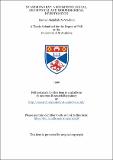Files in this item
St Andrews Bay: A sedimentological, geophysical and morphological investigation
Item metadata
| dc.contributor.advisor | Jarvis, J. | |
| dc.contributor.advisor | Duck, Rob | |
| dc.contributor.author | Al-Washmi, Hamad Abdullah | |
| dc.coverage.spatial | 216 p, [15] p. of plates. | en_US |
| dc.date.accessioned | 2018-07-19T08:24:23Z | |
| dc.date.available | 2018-07-19T08:24:23Z | |
| dc.date.issued | 1996 | |
| dc.identifier.uri | https://hdl.handle.net/10023/15558 | |
| dc.description.abstract | This thesis examines past and present day processes responsible for the morphological development of St Andrews Bay in eastern Scotland. Quaternary glacial events have contributed large volumes of sediment from the Scottish Mainland to the North Sea Basin over the last 3 million years. Since the most recent glacial event, the Late Devensian, which terminated some 14,000 years ago in Scotland, the sediments of the coastal areas have been redistributed by wave and tidal activity. Thus the bathymetry and platform of St Andrews Bay has evolved since that time, although some elements of the morphology appear to predate the last glaciation. The grain size distributions of the bed sediments of the bay show a narrow range of mean sizes between fine and very fine sand. These are indicative of a low energy tidal environment although Quartile Deviation - Median Diameter plots suggest the importance of wave activity in determining their distribution. Current measurements in the bay confirm that the hydrodynamic environment is of low energy with average current speeds rarely exceeding 15 cm s ⁻¹ one metre above the bed. Progressive vector plots show closed ellipses during calm weather but meteorological forcing and wave activity generate residual currents predominantly in the direction of wave propagation or down wind. Application of a transfer function to the current data predicts low rates of bedload transport, the residual of which generally accords with the recent pattern of sedimentation at the head of the bay. The rocky platforms of the southern margins of the bay cannot easily be sub-divided into features at different elevations. No firm evidence is presented for a pre-Late Devensian origin of the platform but it is argued that such a chronology explains the morphology of the platform. Offshore sedimentary sequences, up to 30 metres in thickness, are reported from geophysical surveys which have been laid down since the last glaciation. The units identified reflect changing environments of deposition associated with climatic and sea level changes over the last 14,000 years. | en_US |
| dc.language.iso | en | en_US |
| dc.publisher | University of St Andrews | |
| dc.subject.lcc | QE264.F5W2 | |
| dc.subject.lcsh | Geology--Scotland--Fife | en |
| dc.title | St Andrews Bay: A sedimentological, geophysical and morphological investigation | en_US |
| dc.type | Thesis | en_US |
| dc.type.qualificationlevel | Doctoral | en_US |
| dc.type.qualificationname | PhD Doctor of Philosophy | en_US |
| dc.publisher.institution | The University of St Andrews | en_US |
This item appears in the following Collection(s)
Items in the St Andrews Research Repository are protected by copyright, with all rights reserved, unless otherwise indicated.

